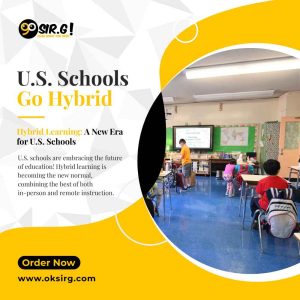US education reform states that the US is moving towards hybrid learning. Let’s see how U.S. schools transition from physical to hybrid learning.
The U.S. instruction framework has experienced noteworthy changes over the years, with crossover learning becoming a noticeable show. This move may be a significant portion of the continuous instruction change as schools. All over the nation grasp unused strategies to meet the differing needs of understudies. Our objective is to investigate the complexities of this move, how it benefits both understudies and educators, and what it means for the longer term of instruction within the U.S.
Whether due to learning inabilities, social uneasiness, or other challenges, these understudies can flourish in a hybrid learning environment that’s custom fitted to their needs. Similarly vital is that cross-breed learning can offer assistance near the accomplishment hole by giving extra bolster and assets to understudies who require them the most.
Understanding Hybrid Learning in the Context of Education
Cross-breed learning, a mix of conventional classroom and online learning, is central to current instruction change endeavors. We recognize that half-breed learning offers adaptability, permitting understudies to memorize at their possess pace while still profiting from face-to-face interaction with instructors. Additionally, this show is particularly compelling in catering to diverse learning styles, which may be vital to modern education change. Instruction change isn’t almost about integrating innovation into classrooms. It’s about making a more inclusive, adaptable, and student-centered approach. As we move forward, cross-breed learning will become a foundation of instruction reform.

The U.S. Schools Transition to Hybrid: A Gradual Yet Impactful Shift
The move to half-breed learning in U.S. schools has been a continuous preparation. One that reflects our commitment to advancement and advancement in education. At first, half-breed learning received on a small scale, but its victory was driven to more extensive usage. This move is not without its challenges, but it is clear that the benefits far exceed the difficulties. U.S school transition to half-breed learning has been driven by the got to address the impediments of conventional classroom settings. For occurrence, expansive course sizes can make it troublesome for instructors to deliver individualized consideration to understudies. Cross-breed learning permits us to overcome this challenge by combining online lessons with in-person sessions, thus optimizing the learning environment.
The Benefits of Hybrid Learning In U.S. Schools: A Comprehensive Approach
Half-breed learning offers various benefits that adjust with the objectives of instruction change within the U.S. Firstly, it cultivates a more locked-in and intuitive learning environment. Understudies could take an interest in discourses, collaborate on ventures, and get quick input, upgrading their learning involvement. Furthermore, hybrid learning permits more noteworthy scheduling adaptability, empowering understudies to adjust their considerations to other obligations.
Crossover learning is also imperative in preparing students for a long time. In today’s computerized age, being capable of utilizing innovation is now not discretionary; it’s a need. By joining innovation into the learning handle, cross-breed learning guarantees that understudies create the abilities they need to succeed in the advanced workforce. Likewise, teachers also take advantage of this show because it provides them with more apparatuses to lock in and rouse their understudies.
Addressing Challenges in the US Schools Transition
Despite its numerous focal points, transitioning to crossover learning in U.S. schools has been challenging. One of the foremost critical issues we experienced is the need for instructors to be appropriately prepared and bolstered. Not all teachers are comfortable with innovation, and moving to a cross-breed show requires them to memorize new skills and adjust their teaching strategies. Education reform within the crossover learning setting also concerns understudy engagement and accountability. To relieve this, we have executed procedures such as standard check-ins, intuitive lessons, and parental inclusion to keep understudies on track. In addition, we must moreover consider the money-related suggestions for this move.
Long-standing Time of Education Reform: Grasping Hybrid as the Modern Typical
As we see to haul long, it is evident that half-breed learning will continue to play a central part in U.S. instruction change. This show is not just a brief arrangement but a long-term methodology for making strides in the quality and availability of instruction. We committed to refining and expanding learning to guarantee that it meets the advancing needs of students and teachers alike. U.S. schools’ move to learning represents a noteworthy move in how we approach instruction.
This transition isn’t fair, almost joining innovation into classrooms; it’s around reconsidering the complete educational experience. Education reform earning permits us to make a more personalized, adaptable, and lock-in environment for understudies, essential for their victory in the 21st century. Inevitably, cross-breed learning may become the prevailing demonstration in U.S. schools, with conventional classroom instruction and online learning consistently coordinated.